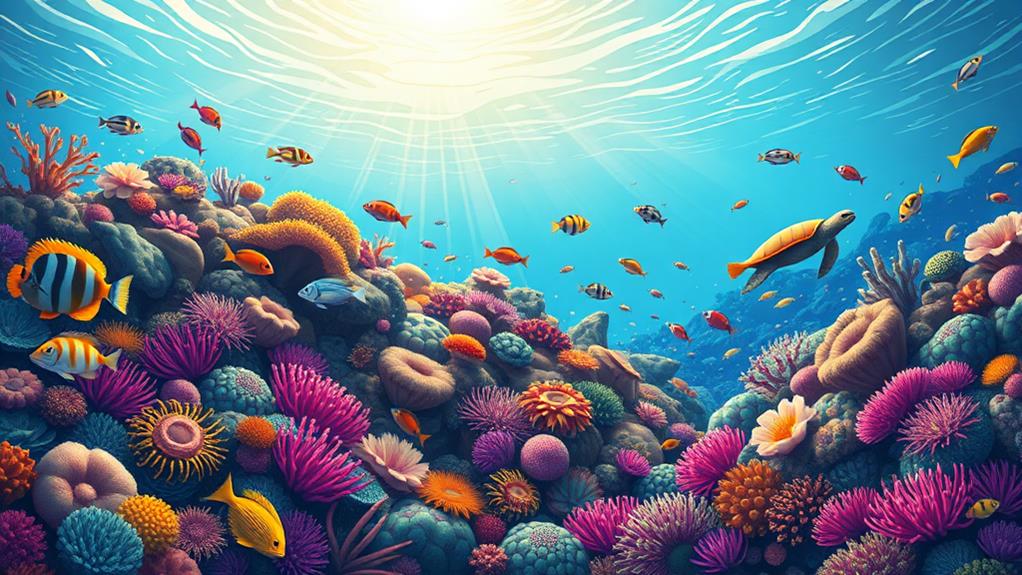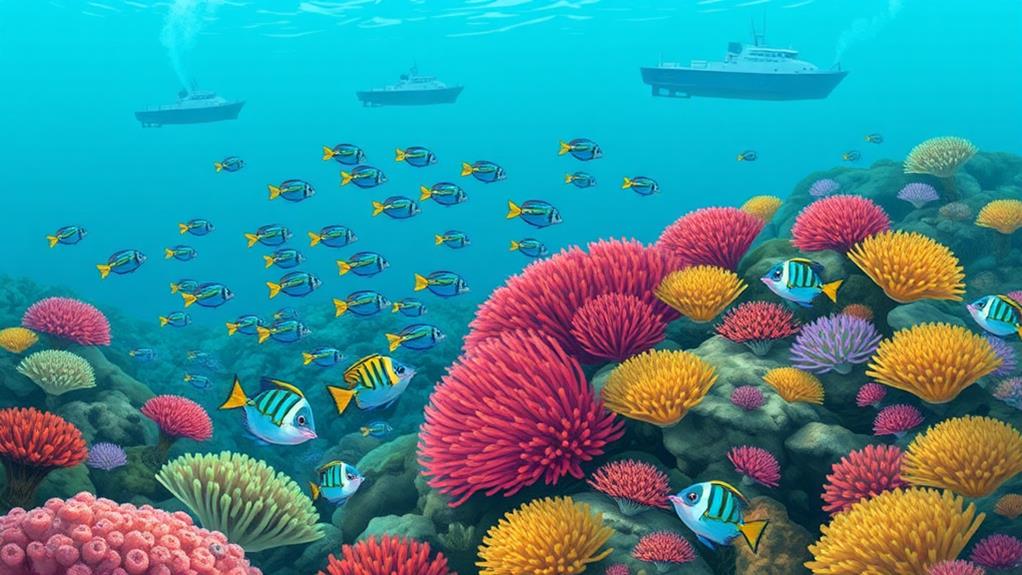The Verde Island Passage: A Hub of Marine Biodiversity
The Verde Island Passage is a 1.14 million-hectare marine corridor that boasts an unparalleled array of marine life, earning it the distinction of being the center of marine biodiversity in the world. This passage is home to an astonishing 1,700 fish species and 300 coral species, making it a hotspot for marine exploration.
As part of the Coral Triangle, the Verde Island Passage provides a habitat for endangered species such as hawksbill turtles, whale sharks, and manta rays. The passage is still yielding new discoveries, with the California Academy of Sciences uncovering around 100 new species in 2015.
Beyond its ecological significance, the Verde Island Passage holds economic importance.
However, it also faces threats that put its delicate ecosystem at risk.
Conservation efforts are underway to protect this precious ecosystem, which still holds many secrets waiting to be uncovered.
Rich Biodiversity of the Passage

The Verde Island Passage is a hotspot for marine biodiversity. Located at the apex of the Coral Triangle, this passage is home to an astonishing array of marine life, with over 1,700 fish species and around 300 coral species.
This incredible variety of species thriving in its waters is due to the passage's ecological significance.
Endangered species like hawksbill turtles, whale sharks, and manta rays inhabit the passage. In fact, researchers from the California Academy of Sciences discovered around 100 new marine species in the area in 2015, highlighting the passage's importance as a hub for marine life.
The Verde Island Passage is recognized as the Center of Marine Shorefish Biodiversity, a testament to its global importance for marine ecosystems.
Its diverse ecosystems, including coral reefs, mangroves, and seagrasses, provide critical habitats essential for maintaining ecological balance and marine health.
Economic Importance and Threats
The Verde Island Passage is a vital economic resource, generating approximately P1 billion annually from fishing activities and supporting local communities that rely on marine biodiversity.
The passage serves as a crucial shipping corridor, connecting major international ports such as Batangas, Manila, and Subic Bay, facilitating significant trade and commerce.
This corridor is essential for the economy, as it enables the transportation of goods and services between these major ports.
Coastal tourism and fisheries put pressure on marine resources, threatening the sustainability of these livelihoods.
For example, overfishing and destructive fishing practices deplete fish stocks, while unregulated tourism can lead to habitat destruction.
Environmental threats jeopardize food security and infrastructure, posing risks to the local economy.
Specifically, illegal fishing, pollution from urban runoff, and climate change are major concerns. These threats can lead to the destruction of marine habitats, loss of biodiversity, and decreased fish catches, ultimately affecting the livelihoods of local communities.
The area's economic viability depends on sustainable practices, highlighting the urgent need for conservation efforts to protect its rich marine biodiversity.
By adopting sustainable practices, such as responsible fishing and tourism, the local economy can thrive while preserving the environment.
Balancing economic development with environmental protection is crucial, ensuring the long-term sustainability of this valuable resource.
This balance can be achieved by implementing policies and regulations that promote sustainable development and protect the environment.
Conservation Efforts and Progress

Conservation Efforts in the Verde Island Passage
Expansion of Marine Protected Areas
Since 2005, partnerships between Conservation International (CI) and local communities have led to a significant expansion of marine protected area networks, covering over 16,000 hectares.
This growth is crucial, as it provides a safe haven for threatened species and preserves the Passage's ecological health.
Empowering Local Communities
CI has empowered local communities by providing training on sustainable practices, enhancing their livelihoods and resilience.
Community engagement is key, with locals actively participating in mangrove rehabilitation and patrolling initiatives to protect marine ecosystems.
Research Initiatives
Ongoing research initiatives, including coral rearing and spawning techniques, are being conducted in collaboration with the California Academy of Sciences to support restoration efforts.
Establishment of Marine Protected Areas
The establishment of marine protected areas and the push for declaring it a protected area reflect the urgent need for effective management mechanisms to safeguard its biodiversity.
Geographic Significance and Features
The Verde Island Passage (VIP) is a critical marine corridor connecting the West Philippine Sea to Tayabas Bay and Sibuyan Sea, located between Luzon and Mindoro in the Philippines.
The VIP's geographic significance and features make it a hub of marine biodiversity. As part of the Coral Triangle, it spans over 1.14 million hectares, boasting an ecological significance that's hard to match.
The passage is home to an incredible array of marine life, with over 1,700 fish species and 300 coral species, supporting a vibrant and diverse marine ecosystem. This concentration of marine life is unmatched, with the highest number of coastal fishes, corals, crustaceans, mollusks, seagrasses, and mangroves, making it a critical habitat for marine life.
The VIP is a designated Marine Protected Area (MPA), enhancing conservation efforts and recognizing its status as a biodiversity hotspot.
The passage supports the livelihoods of coastal communities, who rely on it for food, income, and recreation.
Its unique geography and features also make it an ideal location for scientific research, education, and ecotourism.
Diving Attractions and Historical Value

Verde Island Passage is a premier diving destination due to its crystal-clear waters, which are home to over 1,700 fish species and 300 coral species.
The area's stunning coral reefs and diverse underwater ecosystems attract diving enthusiasts worldwide, offering a glimpse into the vibrant marine biodiversity.
The wreck of a Spanish galleon from 1620 is a historical highlight of Verde Island.
The archaeological significance of the wreck, along with the remnants of porcelain and terracotta jars, draws interest from historians and divers alike.
The unique marine habitats and historical context contribute to Verde Island's status as a significant attraction for eco-tourism and underwater exploration.
With visibility conditions often exceeding 30 meters, you'll be able to experience the underwater landscape and observe marine species in their natural environment.
How Does Laguna De Bay’s Ecosystem Compare to the Marine Biodiversity in Verde Island Passage?
The laguna de bay conservation and development efforts have been crucial in maintaining the balance of its ecosystem. In comparison, the marine biodiversity in Verde Island Passage also benefits from conservation measures. Both areas showcase the importance of preserving natural habitats and promoting sustainable development for future generations.
Future of Marine Conservation
Conservation Efforts Crucial for the Verde Island Passage
The Verde Island Passage's vibrant ecosystems need protection to preserve their rich biodiversity. The passage's recognition as a Hope Spot aims to enhance marine protections and promote sustainable fishing and ecotourism. This recognition will encourage responsible practices that minimize harm to the environment.
Research Initiatives Focus on Ecosystem Health
Ongoing research in the passage focuses on improving the health of marine ecosystems. Coral restoration techniques are being developed and refined to bolster the health of coral reefs. These efforts will help restore damaged reefs and promote the growth of new coral.
Protected Area System Ensures Long-term Conservation
The Verde Island Passage will be integrated into the National Integrated Protected Area System, providing a framework for long-term conservation efforts. This system will ensure consistent and effective management of the passage's resources.
Community Involvement Essential for Conservation
Community involvement in monitoring reef health is essential for effective conservation strategies. To achieve this, initiatives aim to double participation in reef health monitoring activities. This will ensure that local communities are actively engaged in protecting their environment.
Addressing Environmental Challenges
Addressing environmental challenges, such as pollution and industrial activities, is critical to ensuring the sustainable future of the Verde Island Passage's biodiversity. Effective measures must be taken to reduce pollution and mitigate the impact of industrial activities on the passage's ecosystems.
Frequently Asked Questions
What Is the Verde Island Passage Known For?
The Verde Island Passage is a renowned biodiversity hotspot. It boasts an impressive array of marine species and habitats, including coral reefs, mangroves, and seagrass.
This ecological gem is particularly notable for its conservation efforts, which prioritize preserving threatened ecosystems and promoting sustainable practices.
As a hub for research opportunities, it's a treasure trove for scientists studying the ecological importance of its unique biodiversity.
What Is the Center of Marine Biodiversity of the World?
The Coral Triangle is the center of marine biodiversity in the world. This region, which spans across six countries in Southeast Asia, including Indonesia, Malaysia, the Philippines, Papua New Guinea, Solomon Islands, and Timor-Leste, boasts an exceptional array of marine ecosystems, including coral reefs, estuaries, and mangrove forests.
It is home to over 600 species of coral, 2,000 species of fish, and many other creatures, such as sharks, rays, and turtles. This biodiversity hotspot is crucial for ocean health and ecological significance, making conservation efforts essential to mitigate climate impact and maintain the planet's ecological balance.
What Is the Center of Marine Biodiversity of the World?
The Coral Triangle is the center of marine biodiversity in the world. This region, spanning across six countries in Southeast Asia, is home to an exceptionally high level of biodiversity.
It hosts more than 600 species of coral, 2,000 species of fish, and many other creatures. Coral reefs, a key habitat within the Coral Triangle, support complex species interactions and are a crucial area of focus for conservation efforts.
Preserving coral reefs is essential to maintaining ocean health. These delicate ecosystems are highly susceptible to climate change, and their destruction can have devastating effects on the entire marine ecosystem.
By protecting these biodiversity hotspots, we can support the long-term health of our planet's marine life.
What Is the Most Marine Biodiverse Place on Earth?
The most marine biodiverse place on earth is dubbed a "biodiversity hotspot."
These areas support an extraordinary array of marine species.
Coral reefs, in particular, are biodiversity hotspots, hosting an incredible variety of life. They provide crucial services like coastal protection and nursery grounds for fish.
Conservation efforts focus on protecting these ecosystems. Research initiatives are underway to better understand and preserve these precious ecosystems, as climate change threatens ocean health.